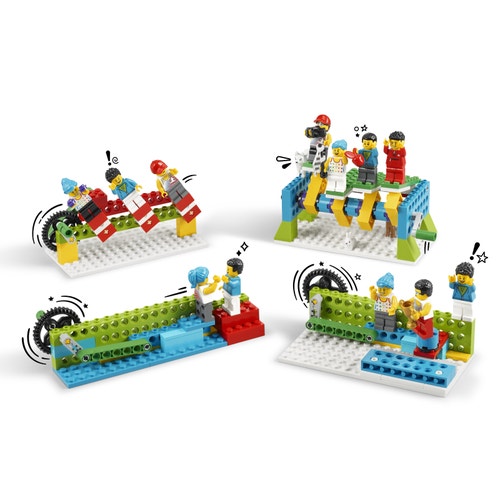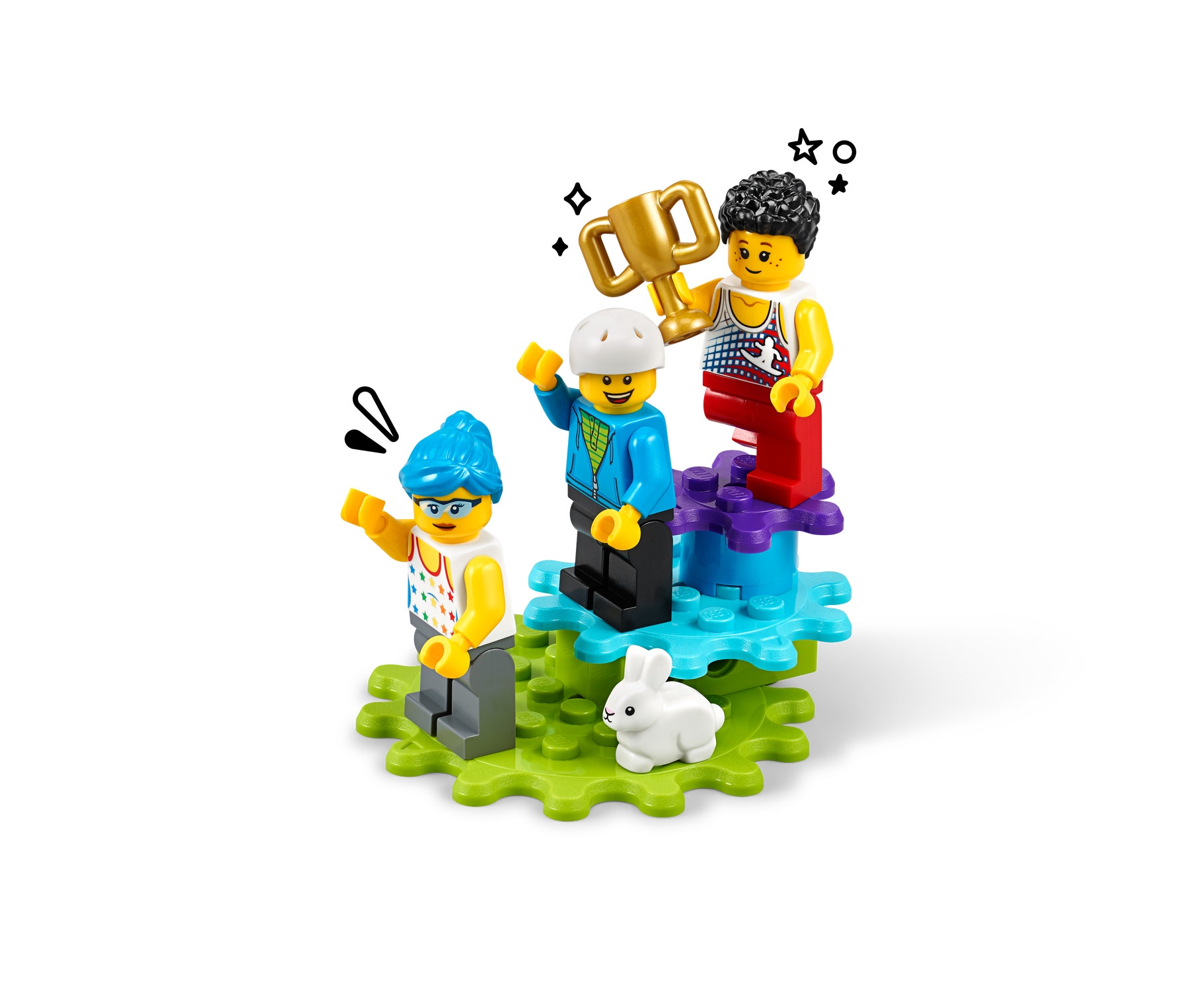Cheering Crowd
Your pupils will explore the engineering design process in this final project, which tests their understanding of balanced and unbalanced forces.
The race is nearly over. The runners come around the final bend, they can see the finish line, and the crowd goes wild!

Prepare
- Review the online pupil material. Use a projector to share this material with your pupils during the lesson.
- This lesson is designed to be facilitated over at least two 45-minute class sessions. Part A comprises session 1, and Part B comprises session 2.
- Make sure that you have covered the relevant concepts (i.e. simple mechanisms, patterns in motion and balanced and unbalanced forces) in an earlier lesson.
- Consider the abilities and backgrounds of all your pupils. Differentiate the lesson to make it accessible to everyone. See the Differentiation section below for suggestions.
Part A (45 Minutes)
Engage
(Whole Class, 5 Minutes)
- Watch the pupil video here or access it via the online pupil material.

- Facilitate a quick discussion about what your pupils observed in the video as the people celebrated the win.
- Ask questions like these:
- How were the people moving? (jumping, waving, giving a high five)
- Think back to the mechanisms in previous lessons. How can you use what you have already learned about forces and motion to create mechanisms that imitate some of these actions?
- Tell the pupils that they are going to design and build an automated mechanism of a cheering crowd.
Explore
(Small Groups, 30 Minutes)
Ask the pupils to invent a mechanism that represents a cheering crowd or celebration.
Have them sketch and build their ideas.
Explain that they can use the models they have built in earlier lessons for inspiration or invent something new.
Encourage them to make models with as many interconnected moving parts as possible.
Tell the pupils to discuss and sketch their ideas before they start building.
You can find building help in the Tips section below.
Explain
(Whole Class, 5 Minutes)
- Gather your pupils together to review and discuss what they have built.
- Ask questions like these:
- How is your model celebrating a win?
- Which models inspired you?
- Which parts of your model are the same as your sketch? What is different?
- What could you change?
- If you require the bricks for another class, take a photo of each group’s build for reference, and then ask the pupils to disassemble their models and tidy up. If you do not require the bricks for another class, you can have the pupils carefully store their models until next time.
Part B (45 Minutes)
Engage
(Whole Class, 5 Minutes)
- Hand out your pupils' sketches or models from Part A of the lesson.
- Have the pupils share what they are planning to do today to refine, improve and finish their models.
- Ask the pupils what they could do if they get stuck. Answers could include:
- Ask a classmate in another group for advice
- Use the building instructions for inspiration
Explore
(Small Groups, 30 Minutes)
- Allow 20 minutes for the pupils to finish their models. After 15 minutes, tell them that they have 5 minutes left to create a functional model.
- Allow them 2 minutes to test their models with their partners.
- If some of the pupils finish building early, have them mark the start and finish lines, 125 cm apart, for a Minifigure race.
- Now gather the pupils for one big class celebration!
Explain
(Whole Class, 5 Minutes)
- Have the pupils explain their models.
- Ask questions like these:
- How well did your model work?
- What could you change to make it even better?
Elaborate
(Whole Class, 5 Minutes)
- Ask questions like these:
- What part of this lesson was fun?
- What was the most challenging?
- Which pupils' models inspired you?
- Allow time for the pupils to disassemble their models, sort the bricks back into the trays and tidy up their workstations.
Evaluate
(Ongoing Throughout The Lesson)
- Ask guiding questions to encourage them to ‘think aloud’ and explain their thought processes and reasoning in the problem-solving decisions they have made when building their models.
Observation Checklist
- Measure your pupils’ proficiency in describing the forces that are at work in their models.
- Establish a scale that suits your needs. For example:
- Requires additional support
- Can work independently
- Can teach others
Self-Assessment
- Have each pupil choose the brick that they feel best represents their performance.
- Green: I think I can describe the forces that are at work in my model.
- Blue: I know I can describe the forces that are at work in my model.
- Purple: I can describe and explain the forces that are at work in my model, and I can help a friend to understand, too.
Peer Feedback
- In their teams, have the pupils discuss their experiences working together.
- Encourage them to use statements like these:
- I liked it when you…
- I'd like to hear more about how you…

Tips
Model Tips
- If any of your pupils are having difficulty, help them by asking open-ended questions, like these:
- What is your idea?
- What have you already tried?
- What could you try next?
- Is there a model that you have already built in another lesson that can make something jump or wave?
- Some pupils might have ideas that are too big to build within the available time. Encourage them to think of ways they could simplify their idea before the next class. Foster their creativity, explaining that many designers take time away from a project to rethink and revise their plans.
- The photos below show sample solutions. However, we recommend not sharing these with your pupils unless they are having trouble coming up with ideas because it tends to limit their creativity.

Differentiation
Simplify this lesson by:
- Having the pupils start by exploring the cam mechanism from page 2 in the building instructions book
Increase the difficulty by:
- Assigning each group 2 mechanisms from pages 2 - 3 of the building instructions book and challenging them to combine both mechanisms into one model
Extensions
(Note: This will require additional time.)
To incorporate the development of language arts skills, have each pupil create a presentation about what they have learned in this lesson and present it to the class.
ACELY1709
Participate in and contribute to discussions, clarifying and interrogating ideas, developing and supporting arguments, sharing and evaluating information, experiences and opinions
ACELY1816
Use interaction skills, varying conventions of spoken interactions such as voice volume, tone, pitch and pace, according to group size, formality of interaction and needs and expertise of the audience
ACELY1710
Plan, rehearse and deliver presentations, selecting and sequencing appropriate content and multimodal elements for defined audiences and purposes, making appropriate choices for modality and emphasis
1:1 Hybrid Learning
Download the Personal Learning Kit lesson plan from the hybrid learning resources.
Teacher Support
The pupils will:
- Brainstorm, sketch, design, prototype, build, test, iterate, rebuild and experiment to make their own mechanisms
- Apply their knowledge of cause and effect, and balanced and unbalanced forces to build an animated Minifigure cheering crowd
- LEGO® Education BricQ Motion Essential Sets (one for every two pupils)
National Curriculum
DT2/1.1a
Use research and develop design criteria to inform the design of innovative, functional, appealing products that are fit for purpose, aimed at particular individuals or groups
DT2/1.2a
Select from and use a wider range of tools and equipment to perform practical tasks accurately
DT2/1.3a
Investigate and analyse a range of existing products
En4/1b
Ask relevant questions to extend their understanding and knowledge
En4/1d
Articulate and justify answers, arguments and opinions
En4/1e
Give well-structured descriptions, explanations and narratives for different purposes
En4/1g
Use spoken language to develop understanding through speculating, hypothesising, imagining and exploring ideas
En4/3.3a
Plan their writing by:
- Discussing writing similar to that which they are planning to write in order to understand and learn from its structure, vocabulary and grammar
- Discussing and recording ideas
En4/3.3b
Draft and write by:
- Composing and rehearsing sentences orally (including dialogue), progressively building a varied and rich vocabulary and an increasing range of sentence structures
- Organising paragraphs around a theme in non-narrative material, using simple organisational devices




